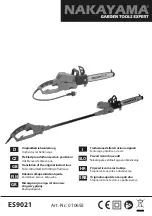
5
•
Store your battery pack and charger in a cool, dry
place – Do not store the battery pack or charger where
temperatures may exceed 104ºF (40ºC), such as in direct
sunlight or inside a vehicle or metal building during
the summer.
Information about the battery
1. The battery pack supplied with your cordless pole chain
saw is only partially charged. The battery pack has to be
charged completely before you use the tool for the
first time.
2. For optimum battery performance, avoid low discharge
cycles by charging the battery pack frequently.
3. Store the battery pack in a cool place, ideally at 59°F
(15°C) and charged to at least 40%.
4. Lithium-ion batteries are subject to a natural aging
process. The battery pack must be replaced at the latest
when its capacity falls to just 80% of its capacity when
new. Weakened cells in an aged battery pack are no
longer capable of meeting the high power requirements
needed for the proper operation of your cordless pole
chain saw, and therefore pose a safety risk.
5.
Do not throw battery packs into an open fire as this poses
a risk of explosion.
6.
Do not ignite the battery pack or expose it to fire. Do not
expose a battery pack or appliance to fire or excessive
temperature. Exposure to fire or temperature above 130°C
may cause explosion. The temperature of 130°C can be
replaced by the temperature of 265°F.
7. Do not exhaustively discharge batteries. Exhaustive
discharge will damage the battery cells. The most
common cause of exhaustive discharge is lengthy storage
or non-use of partially discharged batteries. Stop working
as soon as the performance of the battery falls noticeably
or the electronic protection system triggers. Place the
battery pack in long-term storage only after it has been
fully charged.
8. Protect batteries and the tool from overloads. Overloads
will quickly result in overheating and cell damage inside
the battery housing even if this overheating is not
apparent externally.
9. Avoid damage and shocks. Immediately replace batteries
that have been dropped from a height of more than one
meter or those that have been exposed to violent shocks,
even if the housing of the battery pack appears to be
undamaged. The battery cells inside the battery may have
suffered serious damage. In such instances, please read
the waste disposal information for proper battery disposal.
10.
If the battery pack suffers overloading and overheating,
the integrated protective cutoff will switch off the
equipment for safety reasons.
IMPORTANT!
Do not press the ON/OFF switch any more
if the protective cut-off has been activated. This may
damage the battery pack.
11. Use only original battery packs. The use of other batteries
poses a fire risk and may result in injuries or an explosion.
Information about the charger and the
charging process
1. Please check the data marked on the rating plate of the
battery charger. Be sure to connect the battery charger
to a power supply with the voltage marked on the rating
plate. Never connect it to a different mains voltage.
2. Protect the battery charger and its cord from damage.
Keep the charger and its cord away from heat, oil and
sharp edges. Have damaged cords repaired without delay
by a qualified technician at an authorized Snow Joe
®
+
Sun Joe
®
dealer or call the Snow Joe
®
+ Sun Joe
®
customer service center at 1-866-SNOWJOE
(1-866-766-9563).
3. Electrical plugs must match the outlet. Never modify
the plug in any way. Do not use any adapter plugs with
grounded appliances. Unmodified plugs and matching
outlets will reduce the risk of electric shock.
4. Keep the battery charger, battery pack(s) and the cordless
tool out of the reach of children.
5. Do not use the supplied battery charger to charge other
cordless tools.
6. During periods of heavy use, the battery pack will become
warm. Allow the battery pack to cool to room temperature
before inserting it into the charger to recharge.
7. Do not overcharge batteries. Do not exceed the maximum
charging times. These charging times only apply to
discharged batteries. Frequent insertion of a charged or
partially charged battery pack will result in overcharging
and cell damage. Do not leave batteries in the charger for
days on end.
8. Never use or charge batteries if you suspect that it has
been more than 12 months since the last time they were
charged. There is a high probability that the battery pack
has already suffered dangerous damage (exhaustive
discharge).
9. Charging batteries at a temperature below 50°F (10°C) will
cause chemical damage to the cells and may cause a fire.
10. Do not use batteries that have been exposed to heat
during the charging process, as the battery cells may have
suffered dangerous damage.
11.
Do not use batteries that have suffered curvature or
deformation during the charging process or those that
exhibit other atypical symptoms (gassing, hissing,
cracking, etc.)
12. Never fully discharge the battery pack (maximum
recommended depth of discharge is 80%). A complete
discharge of the battery pack will lead to premature aging
of the battery cells.
13. Follow all charging instructions and do not charge the
battery pack or appliance outside of the temperature
range specified in the instructions. Charging improperly
or at temperatures outside of the specified range may
damage the battery and increase the risk of fire.
14.
Have servicing performed by a qualified repair person
using only identical replacement parts. This will ensure
that the safety of the product is maintained.
Summary of Contents for iON8PS2-CT
Page 24: ...sunjoe com ...






































